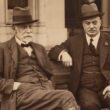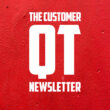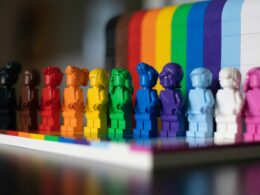In the movie The Best Exotic Marigold Hotel there’s a great line delivered by Maggie Smith in her best, imperious Downton-Abbey-Dowager-Countess-of-Grantham manner: “I came with low expectations and I was disappointed.” So, a less-than-good review for the hotel even in light of somewhat descendent expectations, right? Tourists normally come to hotels with high expectations; to relax, recreate, fine-dine, have mindboggling sexcapdes, and Karaoke. OK, scratch the Karaoke.
Today, in the real world, consumers come to every category with very high expectations. How do I know that? Well, we measure expectations via a combination of psychological inquiry and some really neat higher-order statistical analyses. The analysis informs us as to how high is “up” when it comes to various aspects of what drives brand engagement, loyalty, and behavior. Using psychology to get under the consumers’ “radar,” provides a true measure of what consumers really expect – unconstrained by reality. Reality only plays a minor role in expectation creation. Real expectations aren’t what consumers say they expect but what they feel they expect. There’s a difference.
Consumer expectations are up again. Consumer expectations are always up. Yeah, increases in expectations vary by category but here’s a rule of thumb: Expectations always increase at the speed of the consumer, and almost always faster than brands are able to keep up. Usually brands have to play catch-up when it comes to expectations even when an expectation’s change is pretty manifest.
Sticking with the theme, think about expectations in the hotel industry. Remember the first time you came back from that dreary, interminable business meeting and found a chocolate on your pillow. That was nice! But, as time went on a wrapped chocolate didn’t provide the same frisson de délice. No, now our intrepid traveler expected more. They didn’t articulate it, but they felt it, and what they really expected felt like a chocolate chip cookie! Or next on the expectations escalator, a warm chocolate chip cookie and an icy cold glass of milk. See what I mean?
Or think about the airline that flew you to the city where the hotel you’re staying provided you with your warm cookie and icy cold glass of milk. Only a short time ago your expectations for “Safety” (a critical driver in the airline category) was pretty much condensed to the plane takes off, the plane doesn’t fall out the sky, the plane lands, and if it’s on-time and security didn’t let anyone bring on a gun, well, that was a bonus. Now add COVID-19 into the airline safety equation.
In the blink of a brand marketing eye, the expectation paradigm for that one driver increased so fast you could literally feel it! As the brand, you can’t make believe it didn’t happen. No, no. You have to deal with it, which is why that increase in expectation should matter to marketers. Their abilities to anticipate and meet expectations are a key determinant of customer loyalty, marketing success, and brand profitability. It may help to think of expectations as a brand’s loyalty “North Star.”
Why use the metaphor of the North Star? Well, the North Star is an ideal focal point, stays steadfast as a fixed point in the sky, and has a powerfully successful history as a course-plotting tool. So as the literal heavenly North Star provides directions for travelers, “customer expectations” provides a North Star for marketers seeking strategic direction for their customer journeys.
Metaphorically speaking, your North Star should lead you to activities that cause your brand to better meet – even exceed – expectations consumers hold for the drivers of engagement and loyalty in the category in which you compete. When you identify your North Star expectations, you will absolutely know where you need to concentrate efforts to meet your objectives.
No, no, not “I want to make a gazillion dollars and have sexcapades at hotels that do meet my expectations and don’t have Karaoke,” those are good personal objectives, but first you need to meet a set of brand objectives, and that’s best accomplished by successfully addressing customer expectations. Accomplish your North Star expectation objectives and your personal goals will follow. It’s all pretty straightforward. But saying it and doing it are two different things.
Three truisms regarding why expectations are a flawless North Star for your brand:
- To use another metaphor, expectations operate like oil spills. They don’t stay in one spot. they spread. Categories are different, sure, but categories are not insulated. No category remains unaffected. Increased expectations seep from one category to another. Zappos may have introduced the buy-as-many-shoes-as-you-want-we-won’t-charge-you-anything-for delivery-or-return concept, but now shoppers in every retail category expect free delivery and
- Expectations aren’t static. They grow at the speed of the consumer and faster than brands can keep up, and the more personal the category, the faster expectations grow. On average an annual increase in consumer expectations of 28% might reasonably be anticipated. Brands, on the other hand keep up by five to seven percent leaving an enormous gap between what consumers truly desire and what they see brands delivering. Serendipitously, that expectation gap presents a strategic opportunity. Brands that meet expectations are always category leaders with largest shares-of-market, and, axiomatically, the largest profits, followed shortly thereafter by fulfillment of personal goals including the gazillion dollars and hotel sexcapades sans Karaoke!
- Expectations are mostly emotional and totally unconstrained by reality. Of the 94 categories and 855 individual brands categories Brand Keys tracked in this year’s Customer Loyalty Engagement Index, the average ratio of emotional values to rational values forming the components of expectation is 75:25. Rational primacy-of-product positionings or low-lower-lowest price offers are pretty ineffective responses to expectation growth. Consumers are unwilling to settle for what exists. And they aspire for what they envision à la their category Ideal. Consumers use their ideal as a metaphorical yardstick to determine how brands measure up. Brands that do, see success. The brands that don’t, fade away because expectations are leading-indicators of positive consumer behavior.
If it helps, think of expectations as the strategic North Star that can identify the trajectory a consumer will follow to your brand because correlations between meeting expectations and increased, positive consumer behavior fall into the 0.80 to 0.90 range, which are extraordinarily high. Almost as high as the expectations themselves. Twenty-first century consumers don’t settle for easy, they don’t settle for average, and they don’t settle for ordinary. They demand their expectations be met. A North Star is immensely helpful.
Marketers who ignore these truths, and the true North Star of loyalty, do so at their peril. Ignore expectations and your brand will end up falling off the edge of the earth.
Metaphorically speaking.
 Robert Passikoff is founder and CEO of Brand Keys. He has received several awards for market research innovation including the prestigious Gold Ogilvy Award and is the author of 3 marketing and branding books including the best-seller, Predicting Market Success. Robert is also a frequent contributor to TheCustomer.
Robert Passikoff is founder and CEO of Brand Keys. He has received several awards for market research innovation including the prestigious Gold Ogilvy Award and is the author of 3 marketing and branding books including the best-seller, Predicting Market Success. Robert is also a frequent contributor to TheCustomer.
Photo by PhotographyCourse.net on Unsplash.












1 comment